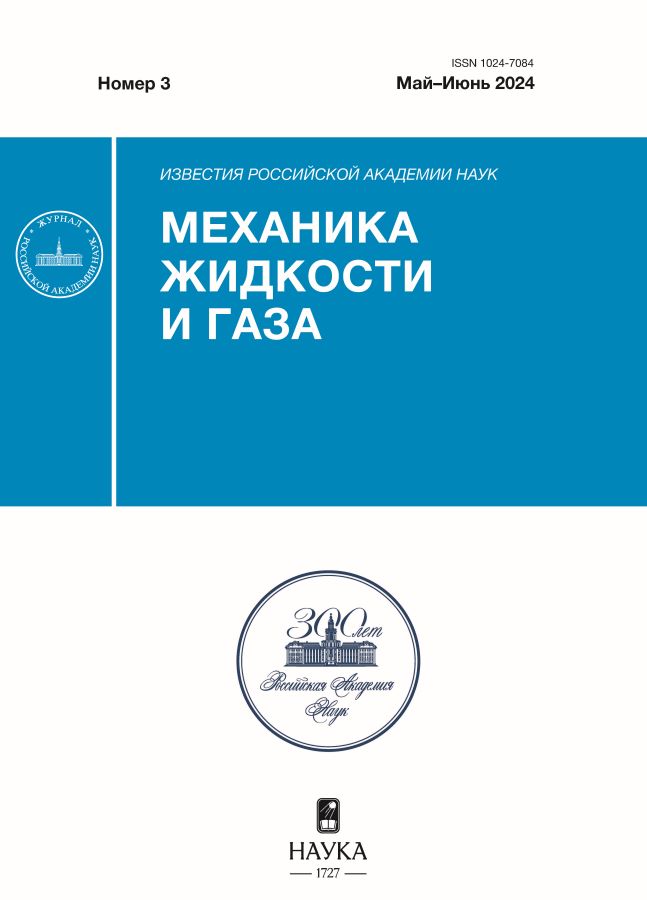Experimental and Numerical Investigation of the Cavitation-Induced Suction Effect
- Авторлар: Ukolov A.I.1, Rodionov V.P.1
-
Мекемелер:
- Kerch State Naval Technological University
- Шығарылым: № 3 (2024)
- Беттер: 20-29
- Бөлім: Articles
- URL: https://rjonco.com/1024-7084/article/view/682509
- DOI: https://doi.org/10.31857/S1024708424030021
- EDN: https://elibrary.ru/PGFDYS
- ID: 682509
Дәйексөз келтіру
Аннотация
The generation of the suction force between a rigid cylindrical frame constricting a submerged cavitating jet and a solid surface is considered. The separation force needed to overcome the suction effect is experimentally determined in a specially developed setup. The dependences of the suction force on the frame diameter and the distance from the nozzle cavitator are obtained using numerical modeling. The volume fraction of the vapor phase inside the frame and the static pressure along the suction surface are calculated. The mechanism of the appearance of the effect and the criteria of its vanishing are explained on the basis of the data obtained.
Негізгі сөздер
Толық мәтін
Авторлар туралы
A. Ukolov
Kerch State Naval Technological University
Хат алмасуға жауапты Автор.
Email: ukolov_aleksei@mail.ru
Ресей, Kerch, 298309
V. Rodionov
Kerch State Naval Technological University
Email: vik-rodio@yandex.ru
Ресей, Kerch, 298309
Әдебиет тізімі
- Родионов В.П. Струйная суперкавитационная эрозия. Краснодар: ГОУВПО КубГТУ, 2005. 223 с.
- Старовойтов П.П., Уколов А.И., Родионов В.П. Инновационный инструмент подводной очистки // Вестник КГМТУ. Сер. Морские технологии. 2019. № 4. С. 105–117.
- Родионов В.П. Суперкавитационная струйная экотехнология водолазных работ. Краснодар: ГОУВПО КубГТУ, 2015. 160 с.
- Родионов В.П, Герасимов В.И. Технологии очистки поверхностей корпусов судов от наслоений и обрастаний. М.: Эдитус, 2022, 190с.
- Chena F., Wanga H., Yin S., Huang S., Tang Q., Luo H. Cavitation water-suction polishing of metallic materials under negative-pressure effect // J. Mater. Process. Technol. 2019. V. 273. P. 116257. doi: 10.1016/j.jmatprotec.2019.116257.
- Ma X., Meng X., Wang Y., Peng X. Suction effect of cavitation in the reverse-spiral-grooved mechanical face seals // Tribol. Int. 2019. V. 132. P. 142–153. doi: 10.1016/j.triboint.2018.12.022
- Cross A.T., Sadeghi F., Cao L.J., Rateick R.G., Rowan S. Flow visualization in a pocketed thrust washer // Tribol. Trans. 2012. V. 55. № 5. P. 571–581. doi: 10.1080/10402004.2012.681343
- Zhang J, Meng Y. Direct observation of cavitation phenomenon and hydrodynamic lubrication analysis of textured surfaces // Tribol. Lett. 2012. V. 46. № 2. P. 147–158. doi: 10.1007/s11249-012-9935-6
- Санкин Г.Н., Малых Н.В. Сила, действующая на цилиндр при ультразвуковой кавитации // ЖТФ. 2005. Т. 75. № 7. С. 101–105.
- Валюхов С.Г., Кретинин А.В., Галдин Д.Н., Баранов С.С. Оптимизационное проектирование проточной части магистрального нефтяного насоса с использованием TURBO инструментов ANSYS // Насосы. Турбины. Системы. 2015. T. 14. № 1. С. 56–68.
- Tsutsumi K., Watanabe S., Tsuda S., Yamaguchi T. Cavitation simulation of automotive torque converter using a homogeneous cavitation model // Eur. J. Mech. B Fluids. 2017. Vol. 61. № 2. P. 263–270. doi.org/10.1016/j.euromechflu.2016.09.001
- Уколов А.И., Родионов В.П., Старовойтов П.П. Моделирование колеса центробежного насоса с максимальным эффектом кавитации // Научно-технический вестник ИТМО. 2017. Т. 17. № 5. С. 910–919. doi: 10.17586/2226-1494-2017-17-5-910-919
- Bakir F., Rey R., Gerber A.G., Belamri T., Hutchinson B. Numerical and experimental investigations of the cavitating behavior of an inducer // Int. J. Rotating Machinery. 2004. V. 10. P. 15–25. doi: 10.1080/10236210490258034
- Уколов А.И., Родионов В.П. Верификация результатов численного моделирования и экспериментальных данных влияния кавитации на гидродинамические характеристики струйного потока // Вестник МГТУ им. Н.Э. Баумана. Сер. Естественные науки. 2018. № 4. T. 79. С. 102–114. doi: 10.18698/1812-3368-2018-4-102-114
- Charriere B., Goncalves E. Numerical investigation of periodic cavitation shedding in a Venturi // Int. J. Heat Fluid Flow. 2017. V. 64. P. 41–54. doi.org/10.1016/j.ijheatfluidflow.2017.01.011
- Omelyanyuk M., Pakhlyan I., Ukolov A., Bukharin N., El Hassan M. Experimental and numerical study of cavitation number limitations for hydrodynamic cavitation inception prediction // Fluids. 2022. V. 7. № 6. P. 198. doi: 10.3390/fluids7060198
- Wang X., Chen Y., Li M., Xu Y., Wang B., Dang X. Numerical investigation of the cavitation performance of annular jet pumps with different profiles of suction chamber and throat inlet // Eng. Appl. Comput. Fluid Mech. 2020. V. 14. № 1. P. 1416–1428. doi: 10.1080/19942060.2020.1824875
- Menter F.R. Two-Equation Eddy-Viscosity Turbulence Models for Engineering Applications // AIAA J. 1994. V. 32. P. 1598–1605. doi: 10.2514/3.12149
Қосымша файлдар















